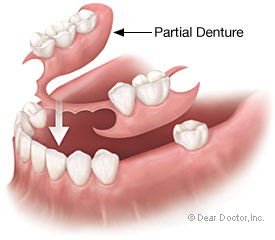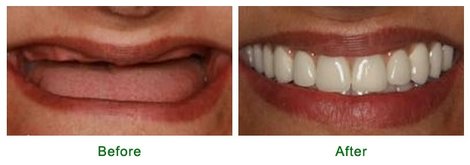Dentures

The Fitting and Care of Dentures
A guide for patients
As we age, our teeth gradually deteriorate. Ageing teeth become brittle and crack or chip more readily. Deep decay adds to the problem.
If present, severe gum disease (called periodontitis) may damage gums and jawbone, leading to tooth loss. If teeth are badly affected by wear, trauma, decay or gum disease, your dentist may suggest extraction as the best treatment option.
Even at a relatively young age, some people have extensive loss of teeth. When many teeth are lost or extracted, a denture may have to be fitted to maintain normal chewing, bite (occlusion), speech and the appearance of the upper and lower jaws.
Millions of people worldwide wear dentures. With today's technology, they look more natural and fit better than ever before. For many people, dentures vastly improve their oral health and appearance.
A denture is called a prosthesis, and the fitting of a denture is called denture prosthodontics; you may hear your dentist use these terms.
A guide for patients
As we age, our teeth gradually deteriorate. Ageing teeth become brittle and crack or chip more readily. Deep decay adds to the problem.
If present, severe gum disease (called periodontitis) may damage gums and jawbone, leading to tooth loss. If teeth are badly affected by wear, trauma, decay or gum disease, your dentist may suggest extraction as the best treatment option.
Even at a relatively young age, some people have extensive loss of teeth. When many teeth are lost or extracted, a denture may have to be fitted to maintain normal chewing, bite (occlusion), speech and the appearance of the upper and lower jaws.
Millions of people worldwide wear dentures. With today's technology, they look more natural and fit better than ever before. For many people, dentures vastly improve their oral health and appearance.
A denture is called a prosthesis, and the fitting of a denture is called denture prosthodontics; you may hear your dentist use these terms.

Types of Dentures
Partial denture
A partial denture is made to fill the space left by a few missing teeth. To hold the partial denture in position, clasps are used to secure the denture to nearby natural teeth.
Full denture
A full denture is made when all the natural teeth are missing. It is fitted to replace the upper teeth, lower teeth. or both.
Immediate denture
The dentist inserts an immediate denture at the same appointment as the teeth are extracted. The advantage is that the patient aboids a period without teeth.
Over-denture
An over-denture is a denture that fits:
• over the top of remaining teeth
• over tooth roots that have had root canal treatment, or
• by attachment to dental implants.
Remaining teeth or dental implants act as anchors to secure it in place.
Materials
Dentures can be made of acrylic or metal. Your dentist will advise you about the best material for you.
Making and Fitting the Dentures
Dentures are composed of artificial teeth bonded to a plastic base. The dentist makes an impression of the dental arch and remaining teeth (if any), using a special impression material. The colour and shape of the artificial teeth can be closely matched to your natural teeth.
The dentist will help you with these decisions. The dental laboratory uses the impressions and the dentist's specifications to make the dentures.
Your dentist will advise you about how long to wear your new dentures each day. A few days or weeks are needed to become accustomed to the dentures.
Over the first few days:
• the denture may feel tight and uncomfortable
• the denture may feel bulky, as if crowding the mouth
• your gums may feel sore
• some people experience a gagging sensation at the back of the throat
• you may notice an increase in the amount of saliva in your mouth
• eat soft foods
• speech may be affected but will improve. Wearers of partial dentures may find their speech improves immediately because missing teeth have been replaced
Denture Adjustment
After some time, the denture may feel loose and awkward. Your dentist can adjust fit. This is done by placing and inner lining in the denture. Several adjustments may be required before the final fit is satisfactory for the longer term.
Over-dentures and partial dentures usually need fewer adjustments than full dentures. People who have retained some natural teeth usually have less gum shrinkage and fewer changes in the underlying jawbone, so their dentures may retain a good fit for longer.
Loose dentures can cause irritation and ulcers of the gums that are painful and may become infected. If your dentures become loose, see your dentist to have them adjusted.
Do not try to adjust your own denture. It has been carefully made to fir your mouth. Home repairs will end up causing more harm than good.
Cleaning Your Dentures
Clean your dentures after each meal or at least twice a day. Remove them, and rinse away food particles with warm or cold water. Some people also like to use a mouthwash.
If you have a partial denture, be sure that you thoroughly clean it to reduce the risk of losing more teeth. Your dentist can show you how to use a toothbrush and dental floss correctly so you can efficiently remove food particles and plaque from remaining teeth.
Brush both the inside and outside surface of your dentures with a soft toothbrush and unperfumed, mild soap or other approved denture cleaner. Many good products are available in pharmacies and supermarkets. It is best to avoid the use of standard toothpastes as many brands are too abrasive.
DO NOT use:
• hot or boiling water because denture will warp
• abrasives
• detergents
• bleaches
• methylated spirits
• other strong chemicals of any kind
Partial denture
A partial denture is made to fill the space left by a few missing teeth. To hold the partial denture in position, clasps are used to secure the denture to nearby natural teeth.
Full denture
A full denture is made when all the natural teeth are missing. It is fitted to replace the upper teeth, lower teeth. or both.
Immediate denture
The dentist inserts an immediate denture at the same appointment as the teeth are extracted. The advantage is that the patient aboids a period without teeth.
Over-denture
An over-denture is a denture that fits:
• over the top of remaining teeth
• over tooth roots that have had root canal treatment, or
• by attachment to dental implants.
Remaining teeth or dental implants act as anchors to secure it in place.
Materials
Dentures can be made of acrylic or metal. Your dentist will advise you about the best material for you.
Making and Fitting the Dentures
Dentures are composed of artificial teeth bonded to a plastic base. The dentist makes an impression of the dental arch and remaining teeth (if any), using a special impression material. The colour and shape of the artificial teeth can be closely matched to your natural teeth.
The dentist will help you with these decisions. The dental laboratory uses the impressions and the dentist's specifications to make the dentures.
Your dentist will advise you about how long to wear your new dentures each day. A few days or weeks are needed to become accustomed to the dentures.
Over the first few days:
• the denture may feel tight and uncomfortable
• the denture may feel bulky, as if crowding the mouth
• your gums may feel sore
• some people experience a gagging sensation at the back of the throat
• you may notice an increase in the amount of saliva in your mouth
• eat soft foods
• speech may be affected but will improve. Wearers of partial dentures may find their speech improves immediately because missing teeth have been replaced
Denture Adjustment
After some time, the denture may feel loose and awkward. Your dentist can adjust fit. This is done by placing and inner lining in the denture. Several adjustments may be required before the final fit is satisfactory for the longer term.
Over-dentures and partial dentures usually need fewer adjustments than full dentures. People who have retained some natural teeth usually have less gum shrinkage and fewer changes in the underlying jawbone, so their dentures may retain a good fit for longer.
Loose dentures can cause irritation and ulcers of the gums that are painful and may become infected. If your dentures become loose, see your dentist to have them adjusted.
Do not try to adjust your own denture. It has been carefully made to fir your mouth. Home repairs will end up causing more harm than good.
Cleaning Your Dentures
Clean your dentures after each meal or at least twice a day. Remove them, and rinse away food particles with warm or cold water. Some people also like to use a mouthwash.
If you have a partial denture, be sure that you thoroughly clean it to reduce the risk of losing more teeth. Your dentist can show you how to use a toothbrush and dental floss correctly so you can efficiently remove food particles and plaque from remaining teeth.
Brush both the inside and outside surface of your dentures with a soft toothbrush and unperfumed, mild soap or other approved denture cleaner. Many good products are available in pharmacies and supermarkets. It is best to avoid the use of standard toothpastes as many brands are too abrasive.
DO NOT use:
• hot or boiling water because denture will warp
• abrasives
• detergents
• bleaches
• methylated spirits
• other strong chemicals of any kind

